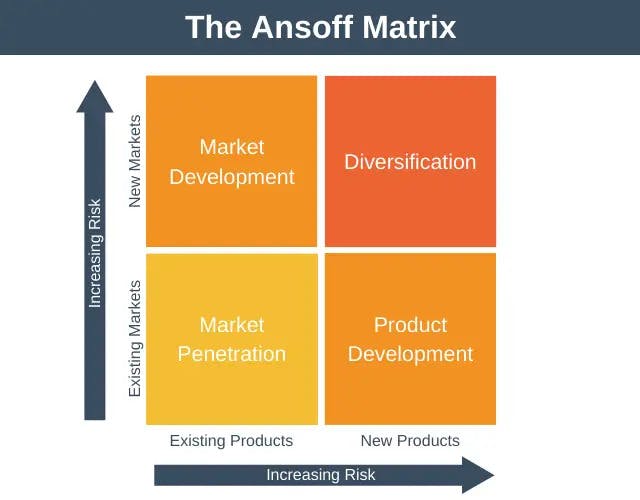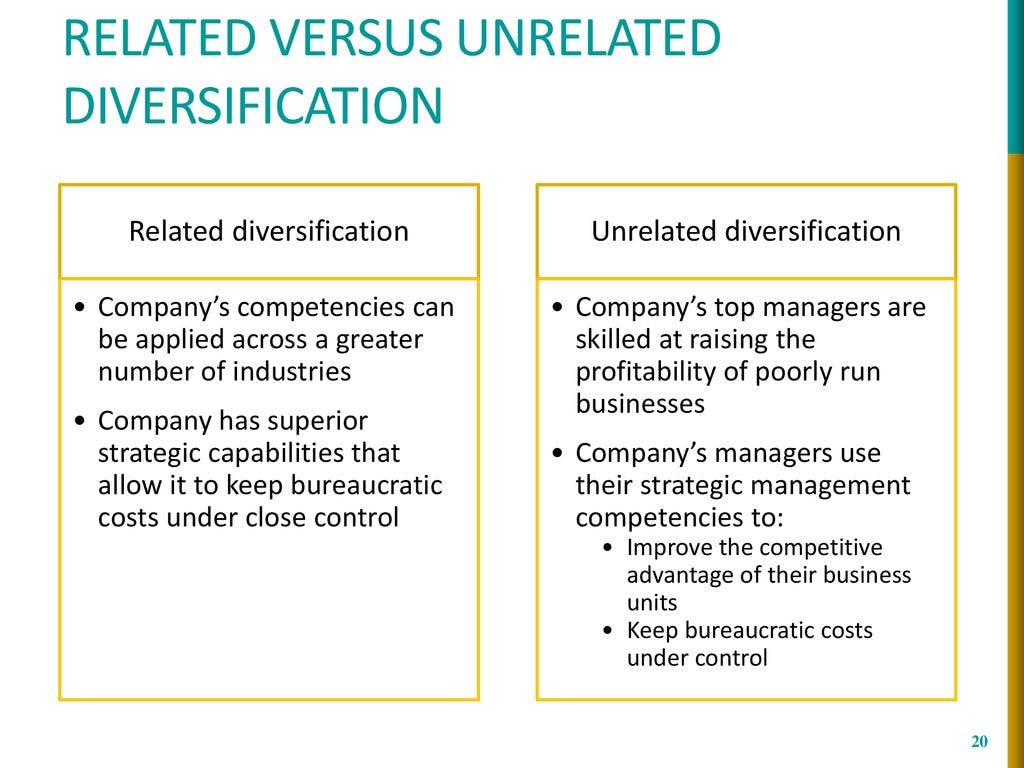Ansoff matrix: overview, strategies and examples
Sep 21st, 2023

Contents
What is Ansoff matrix?
4 strategies of Ansoff matrix
How to use Ansoff matrix?
Ansoff matrix examples
Everyday business opportunities increase at an exponential rate, creating fierce rivalry. Organizations must develop and implement a competitive growth strategy to enhance their economic position in response to this demand for survival. To reduce the chances of failure and the related risks of excessive expenses, they must think through every step of their marketing strategy. Without a strategy, companies can easily miss profitable chances.
Ansoff matrix is a popular tool used by business owners for planning their marketing strategies. The framework provides four opportunities for growth and analyzes risks related to market expansion and product launch. We will discuss these growth methods in this article, as well as how to apply the matrix in practice.
What is Ansoff matrix?
Ansoff matrix is a framework for strategic planning that enables marketing leaders, consultants, and business owners to create and implement effective product and marketing strategies. The matrix is based on the idea that two main methods exist to grow a company: expanding to new markets or developing new offerings. By applying these approaches, the Ansoff matrix provides four methods for expansion: market penetration, product development, market development, and diversification.
The concept was created in 1965 by Igor Ansoff in his book Corporate Strategy. Later, marketers and business executives used this model as inspiration to assess opportunities for growth and related company risks. The matrix may be helpful to a modern marketer, especially for well-defined markets and physical products.

Therefore, by using the framework, organizations may assess the development opportunities and decide their course of action. It prompts businesses to consider their current market position and competitive environment. By understanding different growth strategies, their consequences, and risks, companies can map out a route toward scalable and profitable expansion.
4 strategies of Ansoff matrix
Ansoff matrix illustrates four corporate growth strategies. You may also use it to examine the risks related to each one. The risk rises each time you move into a different quadrant horizontally or vertically. Let's look at each strategy of the matrix more closely.
Market penetration
Market penetration is the least risky approach compared to others. It implies selling the existing offerings in current markets. The strategy aims to grow the market share within existing market segments. Companies may reach this objective by selling more products to regular clients or attracting new consumers within already-established markets.
A business can implement this strategy by decreasing prices (the approach called a penetration pricing strategy), acquiring a rival in the same market, improving marketing efforts or distribution processes, or providing additional benefits that motivate customers to buy more.
It is easier for marketers to create a go-to-market strategy for growth since they are familiar with all the crucial product metrics, such as conversion, average check, and churn. Moreover, maintaining existing markets is often less expensive than expanding into new ones. In addition, this strategy focuses mostly on retaining current customers instead of prioritizing growth marketing.
Market development
A market development strategy is also a low-risk approach as a company must not take on large expenditures into product development or R&D. Instead, a company strives to enter new markets using its current offerings. In other words, businesses focus on finding new market segments to target with their products.
The other approaches include using new sales channels, franchising, concentrating on new areas or regions of the country, entering foreign markets, or selling products to industrial buyers instead of households.

Companies employing this strategy are more likely to succeed if they have a unique product technology they can use in the new market. Moreover, firms can benefit from economies of scale if they increase output. The strategy may also prove successful if the new market is similar to the one where a company already has experience.
Although the advantages of a market development strategy include an expanded target audience, increased revenue, and brand growth, it has some drawbacks. Firstly, the products may not be suitable for some markets and segments. Secondly, a new marketing plan might have an impact on the target market, driving away existing customers.
Product development
When implementing a product development strategy, a company strives to create new offerings catered to its existing markets. This strategy aims to maintain market share and create new sources of revenue by providing customers with novel products. It is riskier than market penetration and has the same level of risk as market development. This is also a strategy that startups use when entering a new market.
To implement this approach, a business may engage in R&D to create new offerings, purchase the manufacturing rights to another company's products or brand, and market a white-label product made by a third party. Besides this, an organization can partner with other business that requires access to the company's brands or distribution networks.
The main advantage of this strategy is that marketers are already familiar with the target audience. They have a base of devoted customers with whom they can conduct surveys and test every design concept before launching the product. Furthermore, a business may develop a brand-new product that will improve the lives of its consumers.
At the same time, launching a new, untested product carries a significant risk. Buyers’ reaction to a new offering is unpredictable. As a result, the product may not sell as expected. Moreover, new product development requires upfront expenses and new product marketing strategies.
Diversification
A company seeks to increase its market share through diversification by launching new products in unexplored markets. Diversification strategy is the riskiest as it involves both product and market development. Although it carries the greatest risk, this approach has the potential to yield significant benefits, such as the achievement of entirely new revenue opportunities or the reduction of a company's reliance on a single product.

The strategy involves two types: related diversification and unrelated diversification. Related diversification may happen when a business enters a new market that is in some way connected to one it already operates in. Unrelated diversification occurs when a company enters a new market that bears little to no resemblance to its current market.
Diversification provides great opportunities if it is used correctly. It is a perfect approach to stand out from the competition. With this strategy, you can enhance market share, expand the customer base, and grow your company. On the other hand, product development is often expensive and time-consuming. A firm may fail to acquire the necessary industry expertise and skills. In addition, new market dynamics are often difficult to predict.
Now, we will go over the ways companies may look at the Ansoff matrix to understand the best strategies to develop their business, marketing and sales strategies, and product lines.
How to use Ansoff matrix?
Once we have described the Ansoff matrix and its elements, it is time to learn how to put it into practice.
Establish your company’s objectives
The first step is to set your business goals. Consider what you want to achieve. Examples of your objectives may include entering a new market, launching a product, or growing your company. Once you have established a goal, you can choose a growth strategy that helps you achieve this objective.
Analyze the current state of your business
Ansoff matrix is a brainstorming tool that can help you in the early stages of your strategic planning. Though it's not a requirement, preparation is the secret to success. Brainstorm ideas with your team. Hold a meeting and specify the information or insights each participant should provide.
Analyze your strengths, weaknesses, opportunities, challenges, and business drivers. You can use a wide range of tools for this purpose, such as Porter’s Five Forces, SWOT analysis, or PESTEL analysis.
Investigate what differentiates your company from competitors and why people prefer your offering over the other products. Conduct a competitor analysis. Examine your current performance, market share, and innovation potential.
Determine your risk tolerance
Each strategy has its unique set of risks. Market penetration carries the lowest level of risk, while diversification carries the greatest one. Therefore, you need to write down the potential threats associated with every strategy and develop a plan for addressing them.
The amount of risk grows as an organization moves outside of its comfort zone. Determine where you want to be on that spectrum and use that information to guide your choice of which quadrant to focus on.

Choose the appropriate strategy
Once you have assessed the risks related to each approach, you can choose the most suitable strategy. If you can accept a low amount of risk, market penetration would be a perfect choice for your business. On the other hand, if you are ready to assume greater risk, you should choose market or product development.
When assessing which strategy to implement, take into account your growth objectives, the benefits and drawbacks of each method, and your current market and product portfolio.
Develop a strategic plan
Now, you should develop a plan for implementing your strategy. It will help ensure that you achieve your growth objectives. Your plan should include clear deadlines, budget, and responsibilities assigned to each team member.
Try formulating strategies for a few different Ansoff matrix quadrants to find which one works best for you. Many businesses pursue two paths at once because of a broad product range.
By identifying your objectives and analyzing risks related to each method, you can choose the best option for your organization.
Ansoff matrix examples
Let's look at some amazing Ansoff matrix examples to get you motivated. Our examples illustrate successful case studies of businesses that have used the matrix as a component of their corporate strategy.
Coca-Cola
If you ever wondered why Coca-Cola is associated with Christmas, the answer is the brand’s aggressive market penetration strategy. Coca-Cola made significant marketing investments to establish a positive association between the holiday and the brand. The target audience of their marketing campaign was existing customers who already enjoyed the drink and Christmas. As a result, a 13% revenue increase for Coca-Cola was directly caused by holiday sales.
IKEA
One of IKEA's primary growth strategies is market development. The largest furniture retailer in the world makes significant investments in the development of new markets. IKEA has 12 different franchisee companies operating in nearly 500 locations across 62 countries. According to forecasts, the corporation will expand into more developing markets in the near future.
Apple
Apple is an outstanding example of a company that successfully employs a product development strategy. The company continues to invest in R&D to enhance its products and add new features to every gadget they introduce. Thus, their clients will constantly be waiting for the next launch of a new product. Since 2007, this strategy has had a favorable impact on the company's sales and helped accelerate Apple's global expansion.
Google employs a diversification strategy to improve sales and expand its market share. It has been developing new products and services since its founding in 1998. The company started as a search engine and has since grown to include hardware, software, and online advertising.
To adapt to emerging trends, Google has enhanced its products over time. The launch of Chrome in 2008 serves as an illustration of this. In addition, the company effectively implemented the diversification strategy when it launched the Android operating system to compete with Apple’s iOS.
Ansoff matrix is a useful tool that allows you to launch new offerings, enter new markets, and diversify your product range. As a result, you will be able to increase your market share and enhance revenue. The secret to effectively implementing these strategies is a thorough analysis of your strong and weak points, competitor research, and a good understanding of the objectives you want to achieve.
